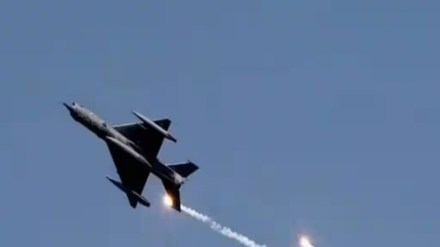The Indian Air Force (IAF) encountered a setback on Tuesday, February 13, 2024, as one of its Hawk aircraft met with an accident during a training sortie in Kalaikunda, West Bengal.
Despite the mishap, the IAF confirmed that both pilots ejected safely, with no loss of life or damage to civilian property on the ground. However, concerns regarding the safety of IAF’s aircraft have been raised, prompting the initiation of a Court of Inquiry (CoI) to determine the cause of the accident.
Hawks & IAF
The Indian Air Force (IAF) has relied on the British-origin Hawk aircraft, specifically the Hawk Mk 132, since 2008. Manufactured by BAE Systems, the Hawk serves as a vital component of the IAF’s training and operational capabilities. This advanced training aircraft boasts a single-engine, jet-powered design, making it well-suited for a range of roles, including ground attacks, flying instruction, weapons training, and aerobatics.
The Hawk’s origins trace back to its maiden flight in 1974 in Surrey, UK. Since then, it has earned a global presence, with operations spanning across 12 countries, including India, the UK, Australia, Canada, and Saudi Arabia. Its versatility lies in its capacity to function both as a training platform and a fully combat-capable aircraft capable of executing air-to-air and air-to-ground missions.
In India, the Hawk Mk 132 variant, featuring tandem seating for a trainee and a pilot, has been instrumental in bridging the training gap between basic piston-engine trainers and advanced fighter aircraft within the IAF ranks. Trainees undergo Stage-III training with the Hawk before progressing to supersonic jets like Jaguars, MiG-21s, and Mirage 2000s.
Powering the Hawk Mk 132 is the Rolls-Royce Adour Mk 871 twin-spool turbofan engine, offering a commendable range of 2,520 kilometers and a top speed of 1,065 kilometers per hour. Its fuel capacity of 2,805 liters ensures sustained operations during training exercises and combat missions alike.
The journey to integrate the Hawk into the IAF’s fleet was not without its challenges. Although the IAF initially articulated its need for an advanced jet trainer (AJT) in 1982, it took until 2004 to finalize the contract for the Hawks. The first two aircraft arrived in 2007, with subsequent acquisitions procured from both BAE Systems and India’s Hindustan Aeronautics Limited (HAL), which played a significant role in domestic assembly.
Today, India boasts the world’s largest fleet of Hawk advanced jet trainers outside the UK, totalling 123 aircraft. These Hawks are stationed primarily at the Bidar Air Force Station, a cornerstone of the IAF’s flying training infrastructure.
The Hawk’s significance extends beyond training purposes. In 2015, it facilitated the revival of the Indian Air Force’s Surya Kiran aerobatics team, which had been grounded for four years due to a shortage of trainer jets. However, tragedy struck in 2019 during a rehearsal for the Aero India show when two Hawks collided at the Yelahanka air force base near Bengaluru, resulting in the loss of one IAF wing commander’s life and injuries to others.
Despite such incidents, the Hawk remains a cornerstone of the IAF’s training and operational capabilities, reaffirming India’s commitment to maintaining a robust defence infrastructure in the face of evolving security challenges.
